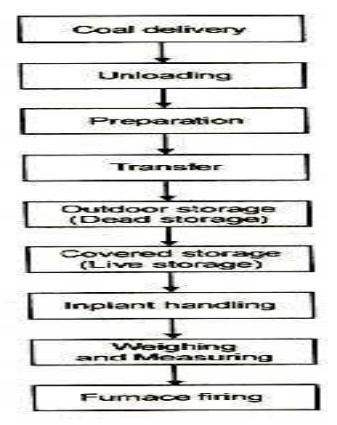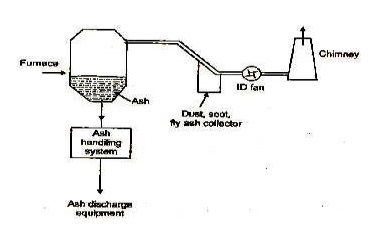Chapter: Mechanical and Electrical : Power Plant Engineering : Steam Power Plants
Steam Power Plants System
STEAM POWER PLANT
Coal needs to be stored at various stages of the
preparation process, and conveyed around the CPP facilities. Coal handling is
part of the larger field of bulk
Material
handling, and is a complex and vital part of the CPP.
FUEL
HANDLING SYSTEM
Coal delivery equipment is one of the major
components of plant cost. The various steps involved in coal handling are as
follows:
1. Coal
delivery.
2. Unloading
3. Preparation
4. Transfer
5. Outdoor
storage
6. Covered
storage
7. Implant
handling
8. Weighing
and measuring
9. Feeding
the coal into furnace

i) Coal delivery
The coal from supply points is
delivered by ships or boats to power stations situated near to sea or river
whereas coal is supplied by rail or trucks to the power stations which are
situated away from sea or river. The transportation of coal by trucks is used
if the railway facilities are not available.
ii) Unloading
The type of equipment to be used
for unloading the coal received at the power station depends on how coal is
received at the power station. If coal delivered by trucks, there is no need of
unloading device as the trucks may dump the coal to the outdoor storage. Coal
is easily handled if the lift trucks with scoop are used. In case the coal is
brought by railways wagons, ships or boats, the unloading may be done by car
shakes, rotary car dumpers, cranes, grab buckets and coal accelerators. Rotary
car dumpers although costly are quite efficient for unloading closed wagons.
(iii) Preparation
When the coal delivered is in the
form of big lumps and it is not of proper size, the preparation (sizing) of
coal can be achieved by crushers, breakers, sizers, driers and magnetic
separators.
iv)Transfer
After
preparation coal is transferred to the dead storage by means of the following
systems.
1. Belt
conveyors
2. Screw
conveyors
3. Bucket
elevators
4. Grab
bucket elevators
5. Skip
hoists
6. Flight conveyor
Belt Conveyor

Figure shows a belt conveyor. It
consists of an endless belt moving over a pair of end drums (rollers). At some
distance a supporting roller is provided at the centre. The belt is made up of
rubber or canvas. Belt conveyor is suitable for the transfer of coal over long
distances. It is used in medium and large power plants. The initial cost of
system is not high and power consumption is also low. The inclination at which
coal can be successfully elevated by belt conveyor is about 20 .Average
speed preferred than other types.
2. Screw Conveyor
It consists of an endless
helicoid screw fitted to a shaft (figure). The screw while rotating in a trough
transfers the coal from feeding end to the discharge end.
This system is suitable, where
coal is to be transferred over shorter distance and space limitations exist.The
initial cost of the consumption is high and there is considerable wear o screw.
Rotation of screw varies between 75-125 r.p.m

3. Bucket elevator
It consists of buckets fixed to a
chain (figure). The chain moves over two wheels. The coal is carried by the
bucket from bottom and discharged at the top.

4. Grab bucket elevator
It lifts and transfers coal on a single rail or
track from one point to the other. The coal lifted by grab buckets is
transferred to overhead bunker or storage. This system requires less power for
operation and requires minimum maintenance.
The grab bucket conveyor can be
used with crane or tower as shown in figure . Although the initial cost of this
system is high but operating cost is less.

Storage
of Coal
It is desirable that sufficient quantity of coal
should be stored.Storage of coal gives protection against the interruption of
coal supplies when there is delay in transportation of coal or due to strike in
coal mines. Also when the prices are low, the coal can be purchased and stored
for future use.
The amount of coal to be stored depends on the
availability of space for storage, transportation facilities, the amount of
coal that will whether away and nearness to coal mines of the power station.
Usually coal required for one month operation of power plant is stored in case
of power stations is situated at longer distance from the collieries whereas
coal need for about 15 days is stored in case of power station situated near to
collieries. Storage of coal for longer periods is not advantageous because it
blocks the capital and results in deterioration of the quality of coal.
PULVERIZED COAL STORAGE
Periodically a power plant may
encounter the situation where coal must be stored for sometimes in a bunker,
for instance during a plant shut down. The bunker, fires can occur in dormant
pulverized coal from spontaneous heating within 6 day of loading. This time can
be extended to 13 days when a blanket of CO2 is piped into the top of the
bunker. The perfect sealing of the bunker from air leakage can extend the
storage time as two months or more. The coal in the bunker can be stored as
long as six months by expelling air from above the coal with the use of CO2 and
then blanketing of all sources of air. A control system used for storing the
pulverized fuel in bunker is shown in figure.
Pulverized Fuel Handling System:
Two methods are in general use to
feed the pulverized fuel to the combustion chamber of the power plant. First is
‘Unit System’ secoandis ‘Centralor
Bin System
‘.
In unit system, each burner of
the plant is fired by one or more pulverizers connected to the burners, while
in the central system, the fuel is pulverized in the central plant and then
disturbed to each furnace with the help of high pressure air current. Each type
of fuel handling system consists of crushers, magnetic separators, driers,
pulverizing mills, storage bins, conveyors and feeders.

Ball Mill
A line diagram of ball mill using
two classifiers is shown in figure. It consists of a slowly rotating drum which
is partly filled with steel balls. Raw coal from feeders is supplied to the
classifiers from where it moves to the drum by means of a screw conveyor. As
the drum rotates the coal get pulverized due to the combine impact between coal
and steel balls. Hot air is introduced into the drum. The powdered coal is
picked up by the air and the coal air mixture enters the classifiers, where
sharp changes in the direction of the mixture throw out the oversized coal
particles. The over-sized particles are returned to the drum. The coal air
mixture from the classifier moves to the exhauster fan and then it is supplied
to the burners.

Ball And Race Mills
In this mill the coal passes
between the rotating elements again and again until it has been pulverized to
desired degree of fineness. The coal is crushed between two moving surfaces,
namely, balls and races. The upper stationary race and lower rotating race
driven by a worm and gear hold the balls between them. The raw coal supplied
falls on the inner side of the races. The moving balls and races catch coal
between them to crush it to a powder. The necessary force needed for crushing
is applied with the help of springs. The hot air supplied picks up the coal
dust as it flows between the balls and races and then enters the classifier. Where
oversized coal particles are returned for further grinding.
ASH HANDLING SYSTEM:
Boilers
burning pulverized coal (PC) have bottom furnaces. The large
ash particles are
collected under the furnace in a
water-filled ash hopper, Fly ash is collected in dust collectors with either an
electrostatic precipitator or a baghouse. A PC boiler generates approximately
80% fly ash and 20% bottom ash. Ash must be collected and transported from
various points of the plants as shown in figure. Pyrites, which are the rejects
from the pulverizers, are disposed of with the bottom ash system. Three major
factors should be considered for ash disposal systems.
1. Plant
site
2. Fuel
source
3. Environmental
regulation
Needs for water and land are
important considerations for many ash handling systems. Ash quantities to be
disposed of depend on the king of fuel source. Ash storage and disposal sites
are guided by environmental regulations.

1 Ash Handling Equipment:
Mechanical means are required for
the disposal of ash. The handling equipment should perform the following
functions: 1. Capital investment, operating and maintenance charges of the
equipment should be low. 2. It should be able to handle large quantities of
ash. 3. Clinkers, shoot, dust etc. create troubles.The equipment should be able
to handle them smoothly.4. The equipment used should remove the ash from the
furnace, load it to the conveying system to deliver the ash to dumping site or
storage and finally it should have means to dispose of the stored ash. 5. The
equipment should be corrosion and wear resistant.

Hydraulic System
In this system, ash from the
furnace grate falls into a system of water possessing high velocity and is
carried to the sumps. It is generally used in large power plants. Hydraulic
system is of two types, namely, low pressure hydraulic system used for
intermittent ash disposal figure. Figure shows hydraulic system.
Water-Jetting System
Water jetting of ash is shown in
figure. In this method a low pressure jet of water coming out of quenching
nozzle is used to cool the ash. The ash falls into trough and is then removed.

Pneumatic System
In this system ash from the
boiler furnace outlet falls into a crusher where a lager ash particles are
crushed to small sizes. The ash is then carried by a high velocity air or steam
to the point of delivery. Air leaving the ash separator is passed through
filter to remove dust etc. So that the exhauster handles clean air which will
protect the blades of the exhauster.

Mechanical system

Figure
shows a mechanical ash handling system.
In this system ash cooled by
water seal falls on the belt conveyor and is carried out continuously to the
bunker.
Related Topics